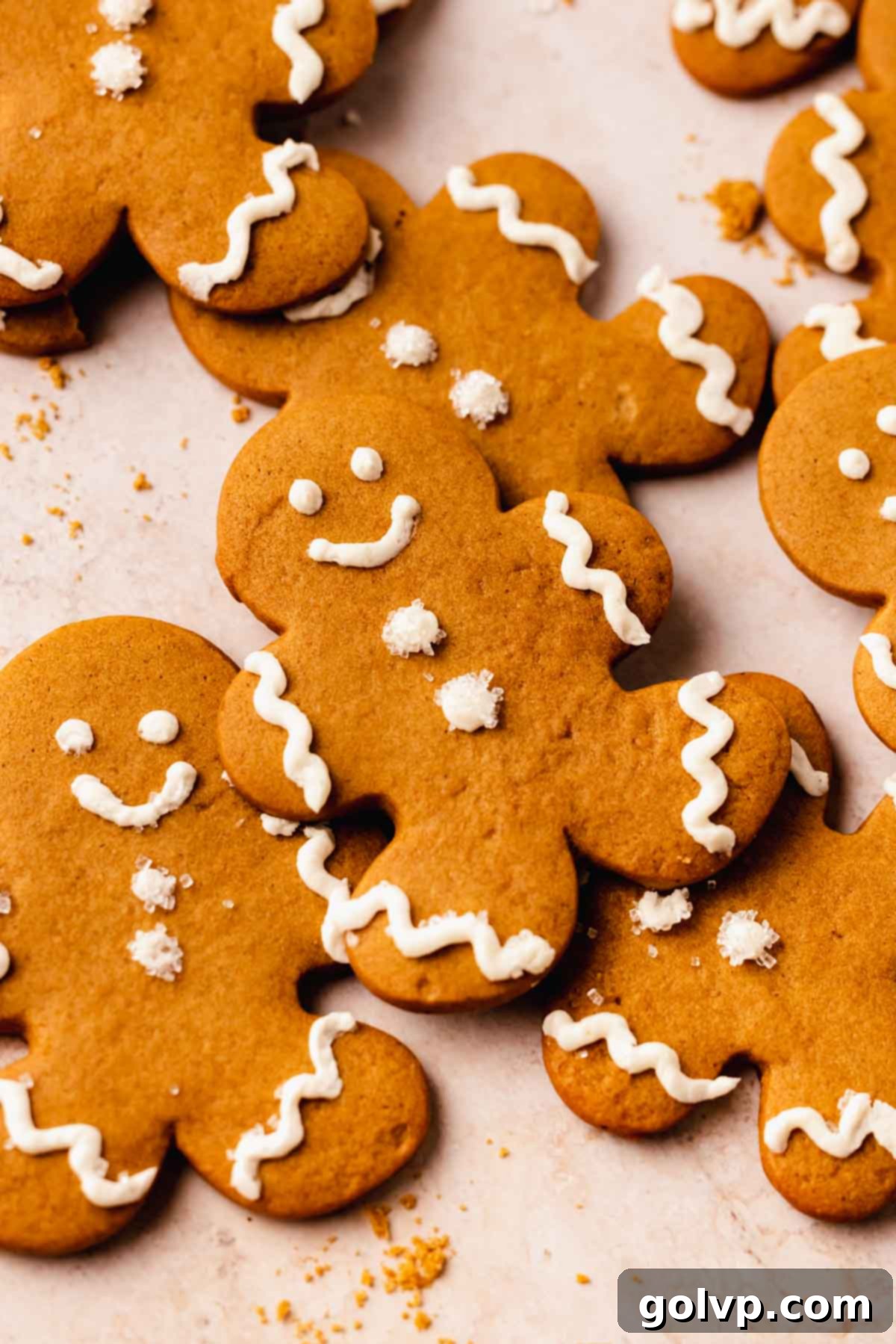The Ultimate Soft & No-Spread Gingerbread Cookies: Your Perfect Holiday Baking Recipe
There’s nothing quite like the aroma of freshly baked gingerbread to usher in the holiday season. These gingerbread cookies are designed to be everything you dream of in a festive treat: incredibly soft, perfectly spiced with a warm blend of classic flavors, and best of all, they consistently hold their charming shapes in the oven without spreading. Forget crumbly, hard, or misshapen cookies – this recipe delivers delightfully chewy cut-out cookies that are an absolute joy to decorate. Whether you’re gathering with loved ones for a fun baking session or preparing a special homemade gift, these cookies are a true crowd-pleaser and undeniably superior to any store-bought variety.
And if you’re looking for another delightful gingerbread treat for Christmas morning or brunch, these easy gingerbread cinnamon rolls are an absolute must-try!

[feast_advanced_jump_to]
🍪 Why You’ll Adore This Gingerbread Cookie Recipe
This recipe isn’t just about making cookies; it’s about crafting perfect holiday memories. Here’s why these gingerbread cookies will become your new festive favorite:
- Soft & No-Spread Perfection: Achieving a perfectly shaped cut-out cookie that remains soft and chewy is the holy grail for holiday bakers. This recipe guarantees just that. The dough is formulated to prevent spreading in the oven, ensuring your intricate gingerbread men, stars, or trees come out looking exactly as you intended, with a wonderfully tender texture that melts in your mouth. No more hard, brittle gingerbread – just pure, soft bliss.
- Irresistibly Nostalgic Gingerbread Flavor: The secret to truly captivating gingerbread lies in the harmonious blend of rich molasses and a symphony of warm spices. Our recipe masterfully combines ginger, cinnamon, nutmeg, cloves, and a hint of cardamom (for an extra special touch) to create that classic, comforting aroma and taste profile that instantly transports you to cherished holiday moments. These cookies embody the essence of the season, far surpassing the often bland or overly sweet store-bought versions.
- Effortless to Make & Decorate: We believe holiday baking should be joyful, not stressful. The cookie dough comes together easily, requiring minimal effort to whip up. For decoration, we’ve opted for a simple, pipeable buttercream that’s a dream to work with, even for beginners. While royal icing is an option for a harder finish, our buttercream offers superior flavor and a smooth, creamy texture that makes decorating a fun, accessible activity for everyone, from seasoned bakers to little helpers.
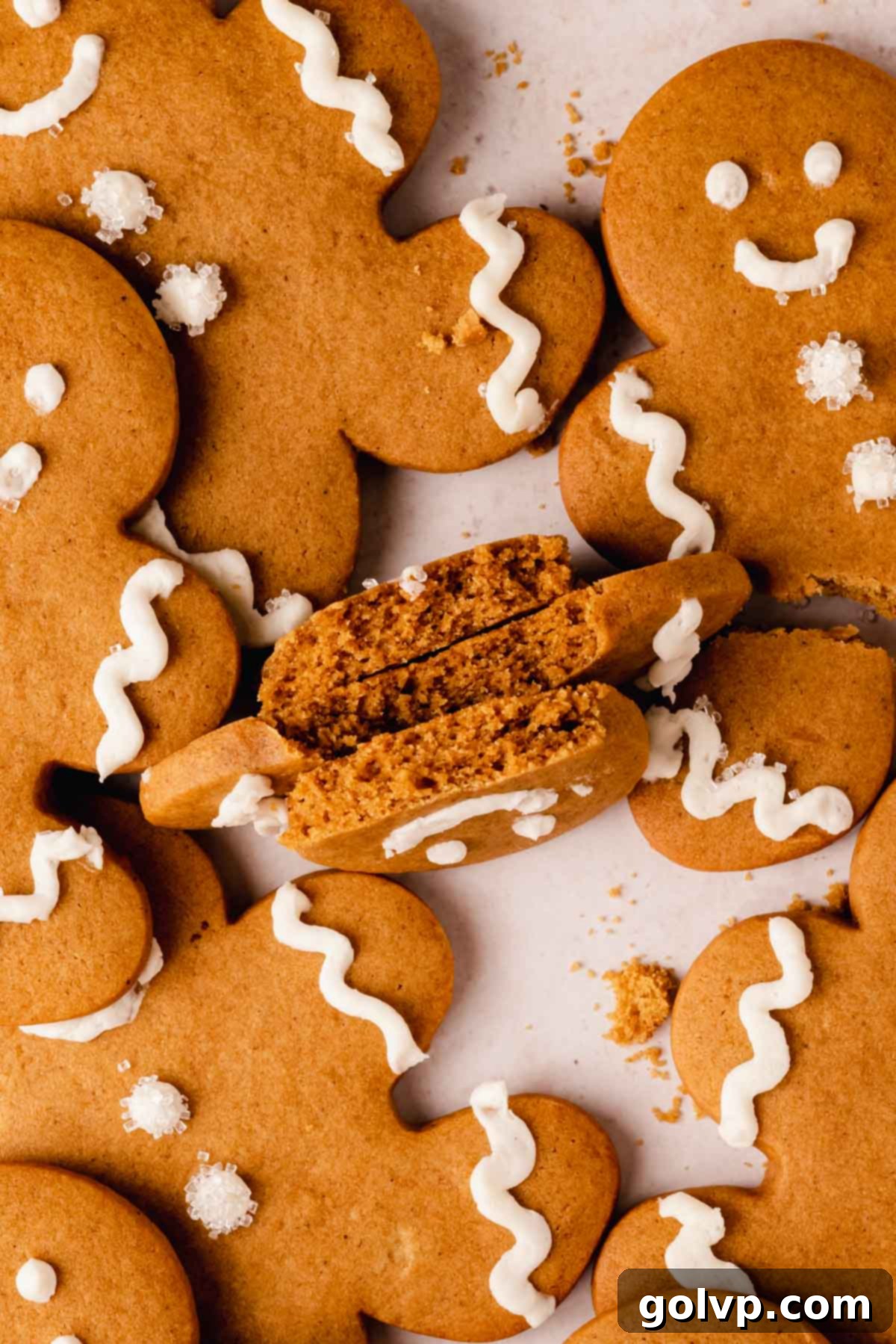
📝 Essential Ingredients for Unforgettable Gingerbread Cookies
Crafting these exceptional gingerbread cookies involves two main components: the incredibly flavorful and tender gingerbread dough, and the smooth, pipeable buttercream for decoration. Using high-quality ingredients is key to achieving the best results.
For a detailed guide with all the tips and precise measurements, make sure to check the full recipe card below!
Full steps and ingredients in recipe card below.
Gingerbread Cookie Ingredients
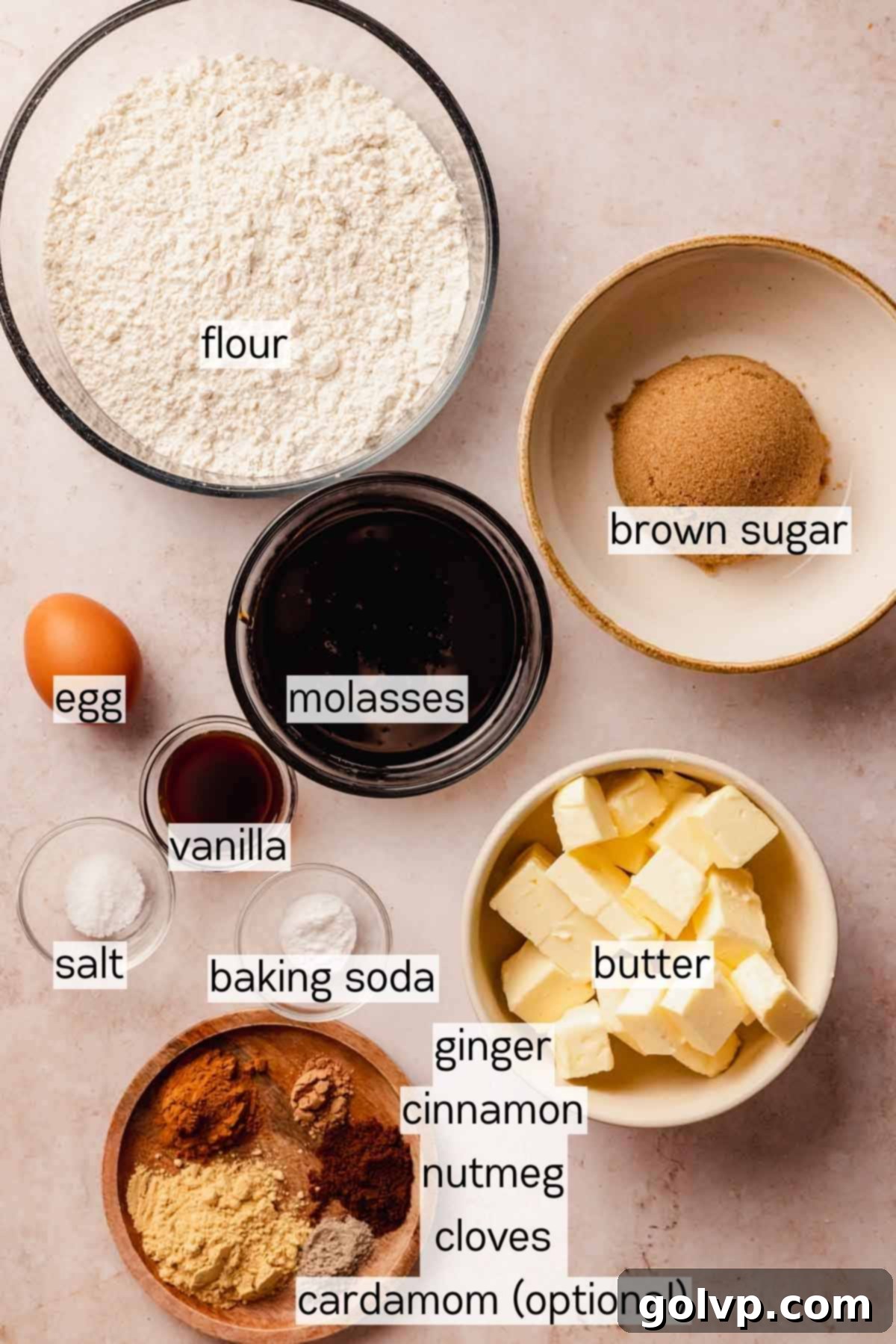
- Molasses: This is the heart of gingerbread flavor. You’ll need an unsulphured baking molasses, specifically medium or dark varieties. These provide the characteristic deep, sweet, and slightly smoky notes. It’s crucial to avoid blackstrap molasses, which is too bitter and lacks the sweetness required for these delightful cookies. If you have any leftover molasses, consider using it to make our gooey gingerbread cinnamon rolls.
- All-Purpose Flour: For baking accuracy, especially with cut-out cookies, weighing your flour is highly recommended. If a kitchen scale isn’t available, proper measuring technique is vital: gently stir the flour in its bag, then spoon it into a measuring cup, leveling off the excess with the flat side of a knife without packing it down. This prevents adding too much flour, which can lead to dry, crumbly cookies.
- Spice Blend (Ginger, Cinnamon, Nutmeg, Cloves, & Cardamom): This carefully balanced blend of aromatic spices is what gives gingerbread its iconic, warming flavor. Ground ginger provides that signature zing, cinnamon adds sweetness and warmth, nutmeg offers a hint of earthiness, and cloves contribute a pungent, sweet-spicy depth. The cardamom is optional but highly recommended; it introduces a delightful floral and citrusy note that elevates the overall complexity of the cookie.
- Butter: Always opt for good quality, real butter. It significantly impacts both the flavor and the tender, melt-in-your-mouth texture of the cookies. Ensure it’s softened to room temperature for optimal creaming with the sugar.
- Brown Sugar: Whether you choose dark or golden brown sugar, its moist texture and caramel notes contribute significantly to the chewiness and rich flavor of these gingerbread cookies. It also helps achieve that beautiful golden-brown hue.
Buttercream Piping Ingredients
- Butter: As with the cookies, good quality real butter is essential for a delicious and smooth buttercream. Softened butter creams easily and incorporates air, resulting in a light and fluffy frosting.
- Icing Sugar (Powdered Sugar): This finely milled sugar is what sweetens and provides the necessary structure and thickness for pipeable buttercream. Sifting it can help prevent lumps, ensuring a silky-smooth frosting.
- Vanilla Extract: Pure vanilla extract is crucial for adding a depth of flavor that complements the sweetness of the buttercream beautifully. Avoid imitation vanilla for the best taste.
- Heavy Whipping Cream: This ingredient is key to achieving a wonderfully fluffy and pipeable buttercream consistency. It helps to lighten the frosting texture. If heavy cream isn’t on hand, whole milk can be used as a substitute, but add it very gradually, a teaspoon at a time, to reach the desired consistency, as milk is thinner than cream.
✔️ Ingredient Substitutions & Creative Variations
While this recipe is perfected with the listed ingredients, a few substitutions are possible if needed, or if you want to explore different flavor profiles:
- Cloves: If you’re out of ground cloves, allspice makes an excellent substitute due to its very similar warm, sweet, and slightly peppery flavor profile.
- Royal Icing for Decorating: For decorations that need to set hard and firm – ideal for stacking, packaging, or shipping your gingerbread cookies – you can substitute the buttercream with royal icing. Royal icing dries completely, creating a protective, crisp shell. However, for sheer ease of preparation and a more delicious, creamy taste experience, buttercream remains our top recommendation for immediate enjoyment.
- Spices: Feel free to adjust the spice levels to your preference. For a milder cookie, slightly reduce the ginger and cloves. For an extra kick, add a pinch of black pepper or a bit more ginger.
👩🍳 Step-by-Step Guide: Crafting Your Perfect Gingerbread Cookies
Follow these detailed steps to create beautiful, soft, and perfectly spiced gingerbread cookies that everyone will love. Precision in each step ensures the best results.
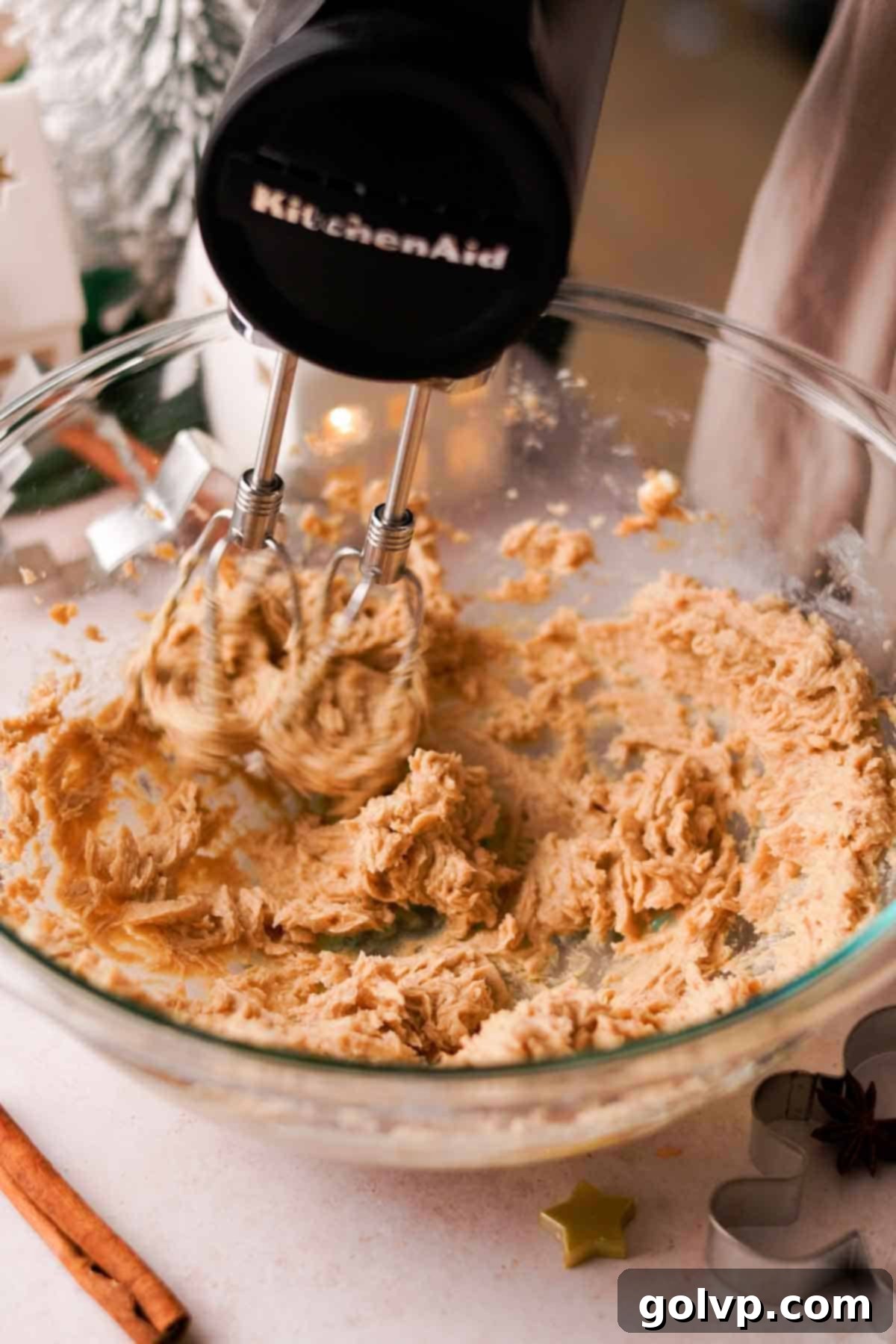
Step 1: Cream the Butter and Sugar. In a large mixing bowl or the bowl of a stand mixer fitted with the paddle attachment, combine the softened unsalted butter, packed brown sugar, and sea salt. Beat these ingredients together on medium speed until the mixture becomes wonderfully light, fluffy, and creamy. This creaming process incorporates air, contributing to the cookies’ soft texture. Remember to scrape down the sides of the bowl periodically to ensure even mixing.
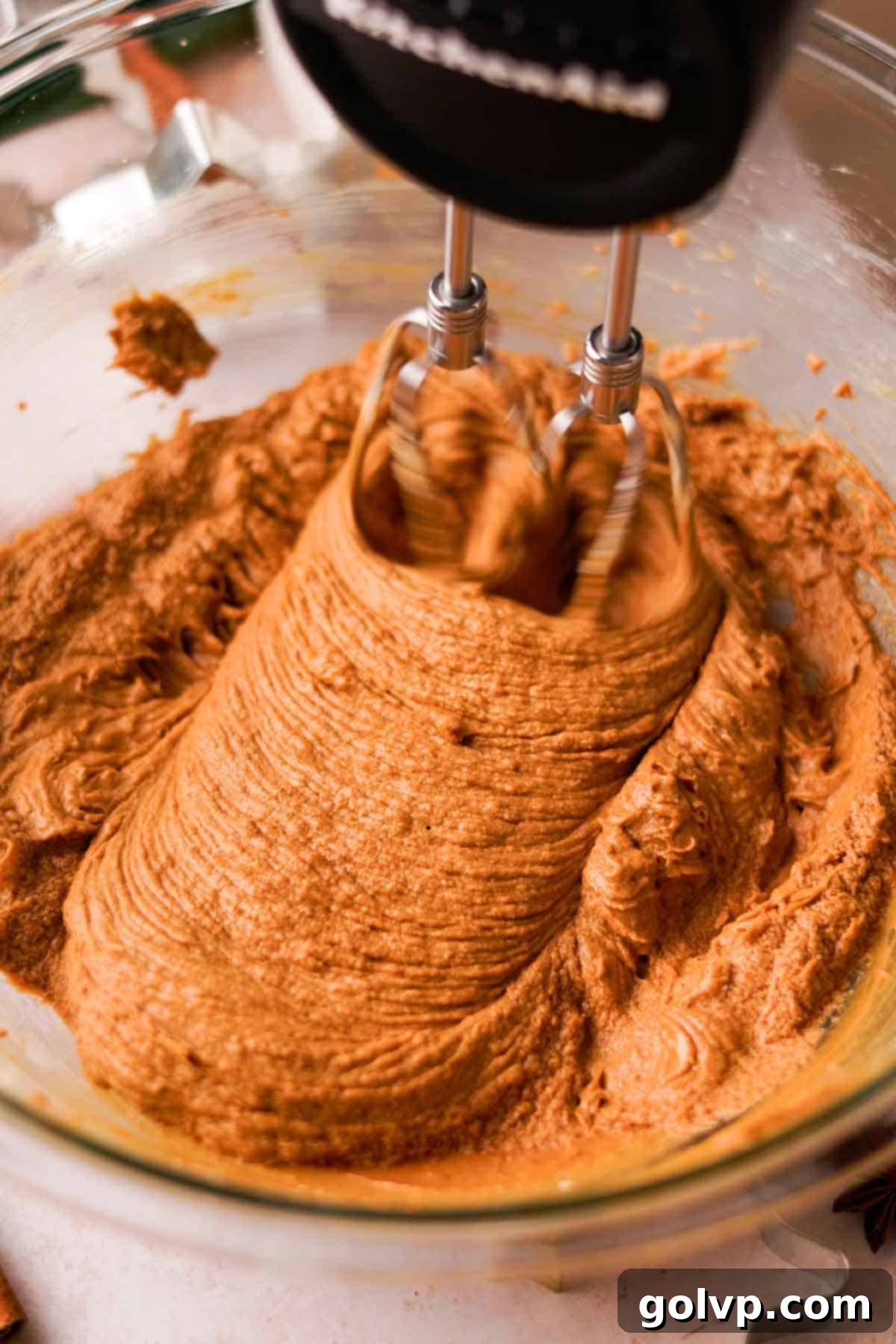
Step 2: Incorporate Wet Ingredients and Spices. Add the large egg (at room temperature for better emulsion), pure vanilla extract, and the unsulphured molasses to the creamy butter and sugar mixture. Continue to beat on medium speed until the mixture is fully combined, smooth, and light in color. Don’t forget to scrape down the bowl’s sides once more. Next, add all the ground spices directly into the same bowl: ginger, cinnamon, nutmeg, cloves, and the optional (but highly recommended) cardamom. Beat just until the spices are evenly distributed, filling your kitchen with an intoxicating aroma.

Step 3: Add Dry Ingredients. Sift the all-purpose flour and baking soda directly into the bowl with the wet ingredients. Sifting helps to aerate the flour and remove any lumps, ensuring a smooth dough. Gently fold the dry ingredients into the wet mixture using a spatula until a cohesive dough forms. Mix only until no dry streaks of flour are visible. Overmixing at this stage can develop too much gluten, resulting in tough cookies.
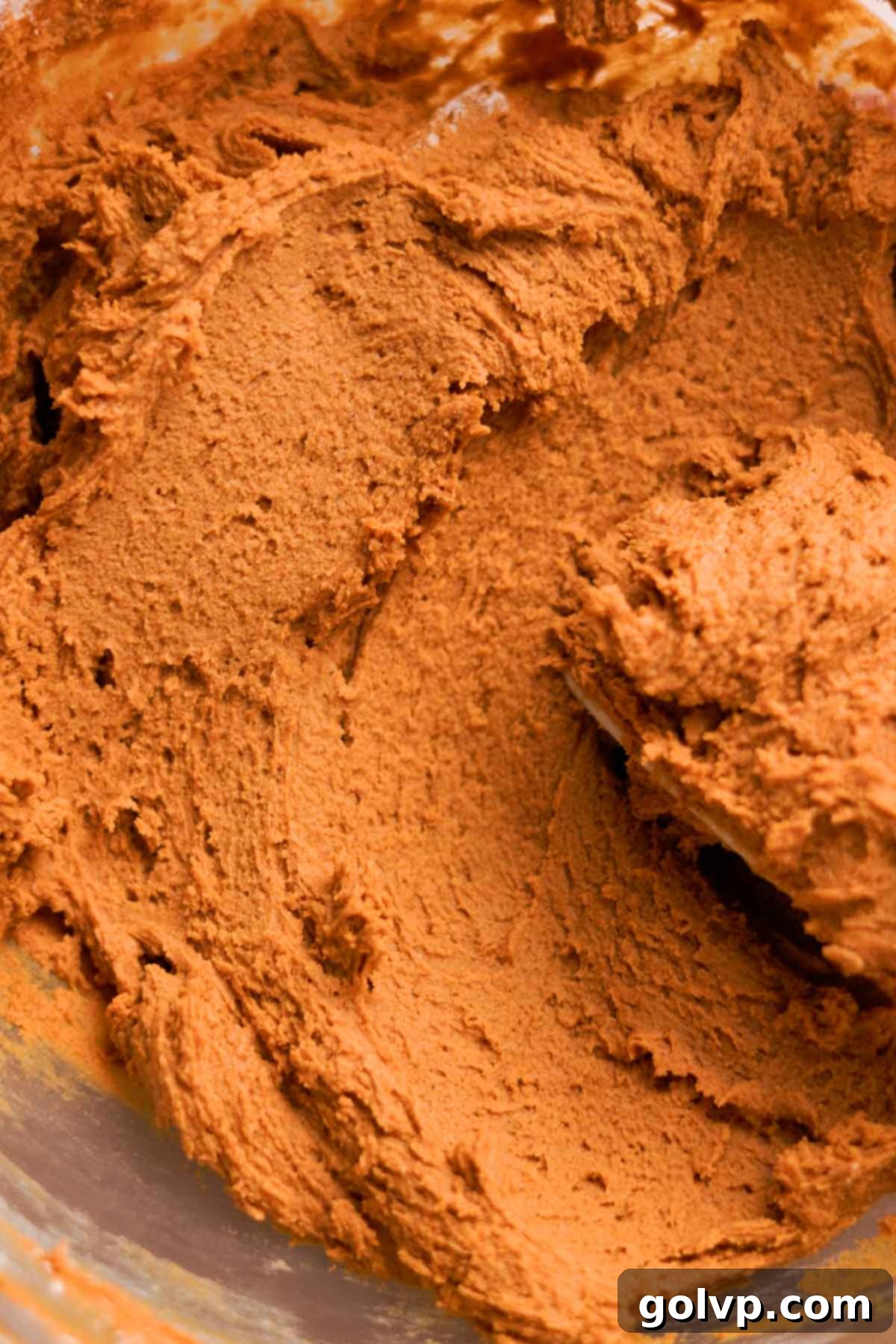
Step 4: Avoid Overmixing the Dough. It’s crucial not to overmix the dough once the flour is added. The dough might feel a bit sticky at this point, but don’t worry – this is normal. It will firm up beautifully once it has been properly chilled, making it much easier to handle and roll out without needing additional flour, which can dry out the cookies. Trust the process, and resist the urge to keep mixing!
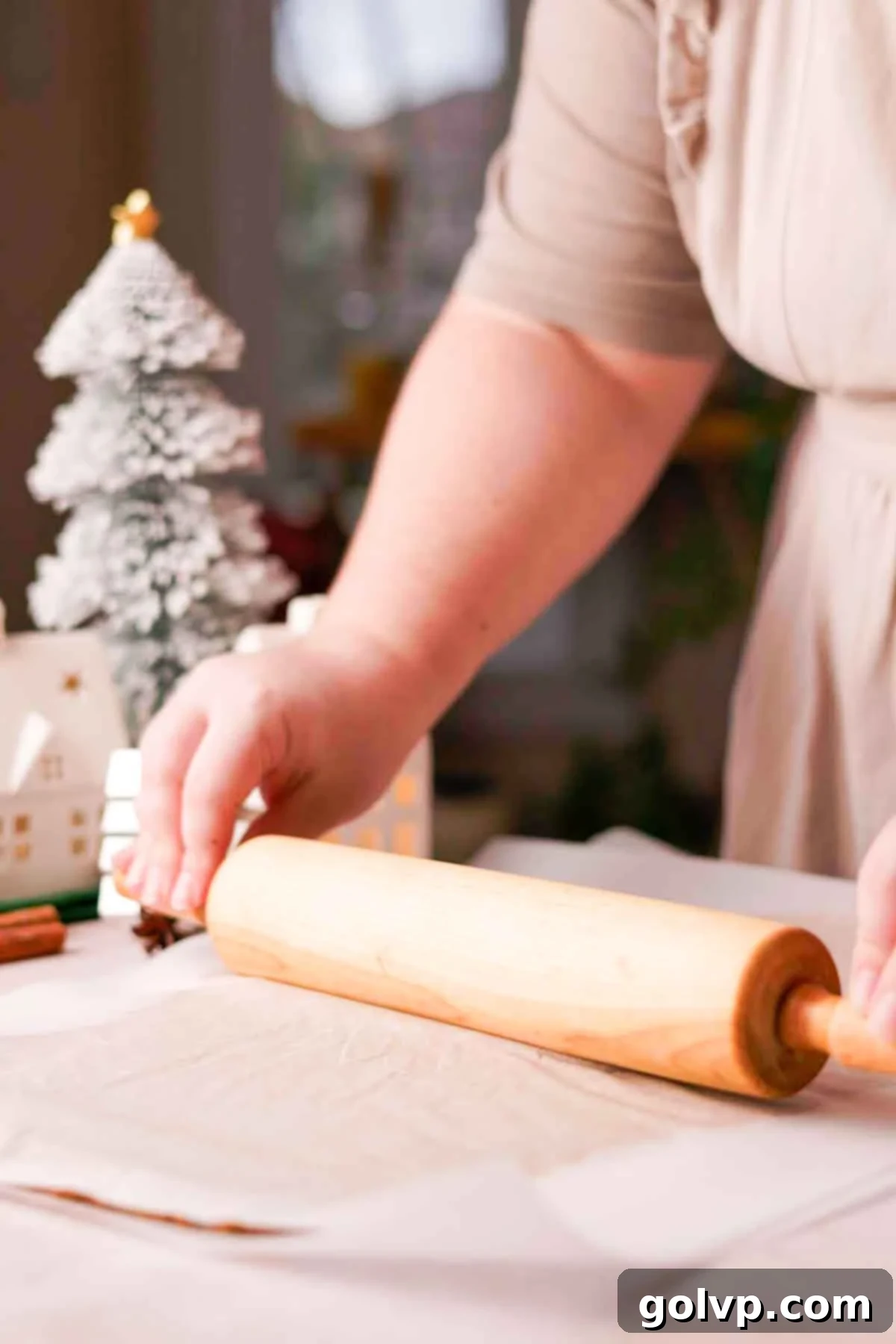
Step 5: Roll and Chill the Dough. Divide the gingerbread dough into two equal halves. Place one half onto a large sheet of parchment paper. Cover it with another sheet of parchment paper. Using a rolling pin, roll the dough out evenly until it reaches a consistent thickness of ¼ inch. Repeat this process with the second half of the dough. Stack both rolled-out dough sheets (still encased in parchment) on a baking sheet to keep them flat. Transfer the baking sheet to the freezer and chill the dough for 30-60 minutes, or even overnight, until it is very firm. This chilling step is essential for preventing cookie spread during baking.
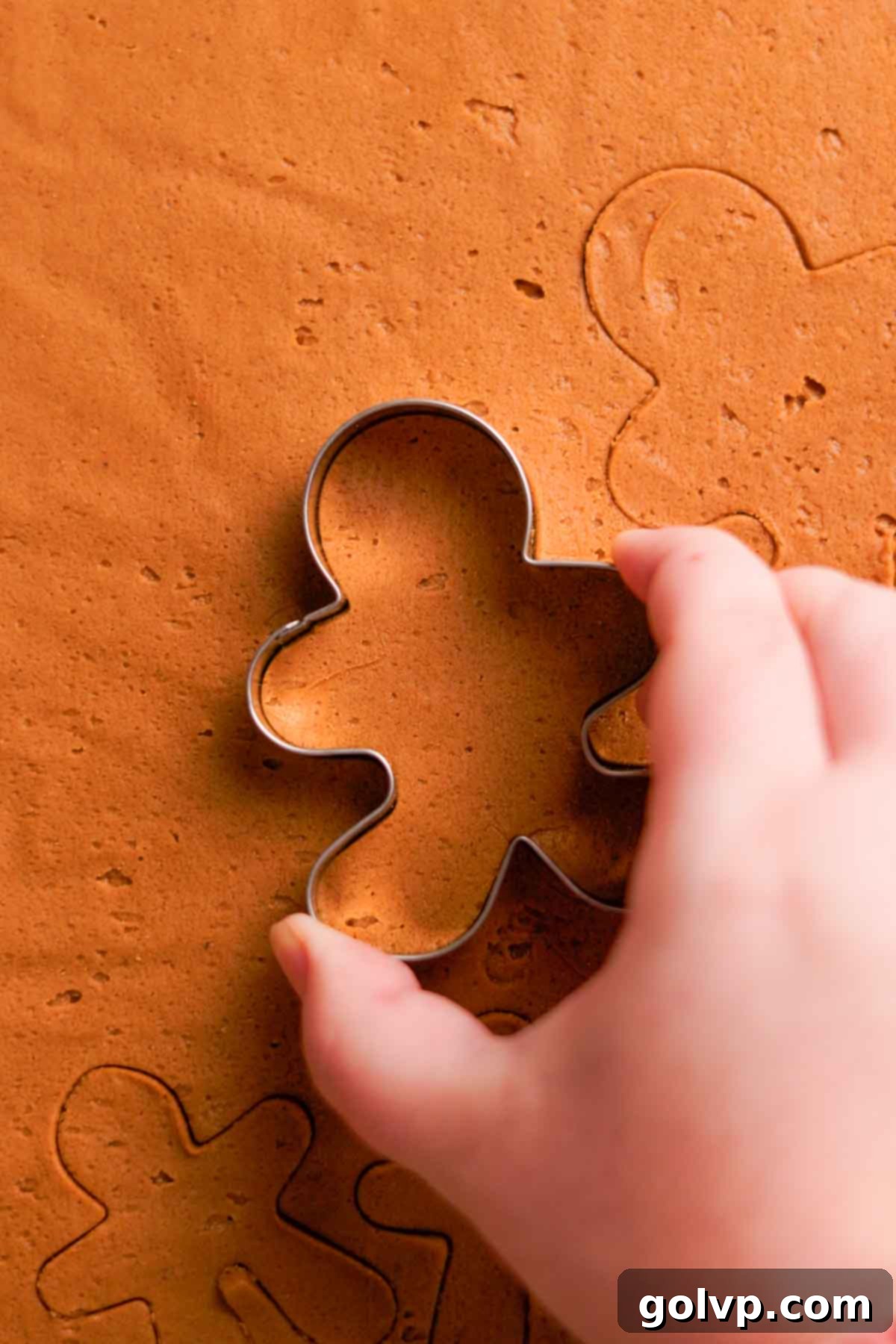
Step 6: Preheat and Cut Out Shapes. While your dough chills, preheat your oven to 355°F (180°C). Line a large baking sheet with fresh parchment paper. Once your dough is sufficiently chilled, take out one sheet. Carefully peel off the top layer of parchment paper. A helpful trick: place the parchment back down gently without pressing, then flip the entire sheet of dough over and peel off the *other* layer of parchment. This leaves your firm dough resting perfectly on a single sheet of parchment, ready for cutting. Use your favorite cookie cutters to create festive shapes, placing them as close together as possible to minimize scraps. Gently remove the excess dough around your cut-out shapes and set it aside for re-rolling.
Pro Tip for Easy Cutting: The parchment paper trick mentioned in Step 6 is a game-changer! It ensures the dough stays flat and intact, preventing stretching or tearing as you cut your shapes, leading to perfectly formed cookies.
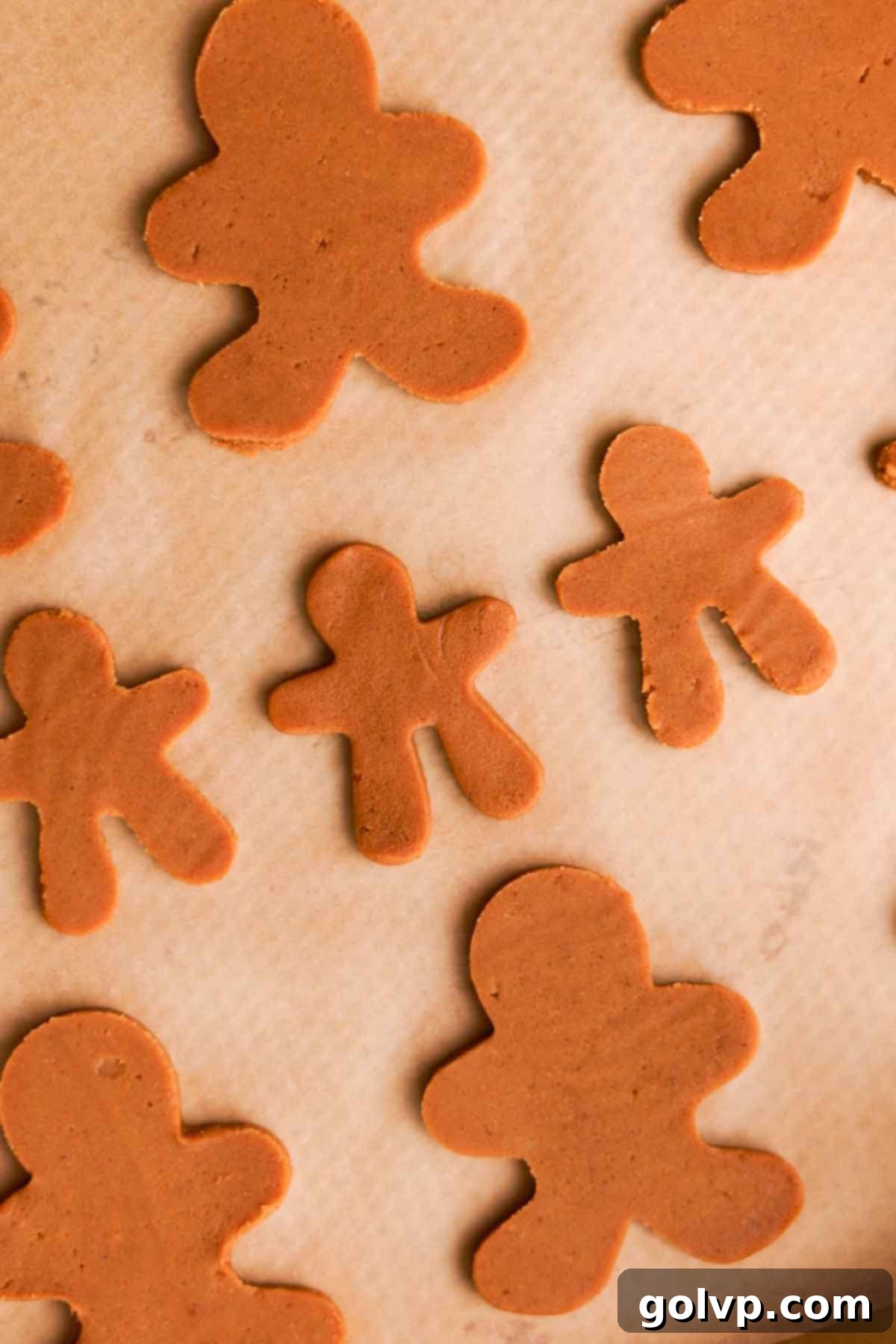
Step 7: Prepare for Baking. Carefully transfer your cut-out cookies to the prepared parchment-lined baking sheets, ensuring you leave at least 1 inch of space between each cookie to allow for slight expansion. If the cookies have warmed up significantly while you were cutting them, pop the baking sheet back into the freezer for 5 minutes. Baking cold cookies is another key factor in preventing spread and ensuring they maintain their crisp edges.

Step 8: Bake and Cool. Bake the cookies for 5-8 minutes. Baking times can vary slightly depending on your oven and the size of your cookies. You’ll know they’re done when the tops are no longer shiny and have puffed up a bit. Remember, gingerbread cookies are best when slightly underbaked for that wonderfully soft texture. Remove them from the oven and carefully transfer them to wire cooling racks using a spatula to cool completely. While the first batch bakes and cools, gather your cookie scraps, gently re-roll them between parchment paper (reusing your original sheets is fine), and cut out more shapes until all the dough is used. Once completely cool, unleash your creativity and decorate them with buttercream, a simple glaze, or royal icing to truly bring them to life! For an extra festive touch, I love adding sparkly sugar to the piped buttons.
Decorating Tip: While buttercream is delicious and easy to use, opt for royal icing if you plan to stack or ship your cookies, as it hardens completely and won’t smudge. For cookies enjoyed immediately, creamy buttercream is a delightful choice!
👩🍳 Mastering the Perfect Buttercream Frosting for Cookies
A simple yet luscious buttercream frosting is your ideal companion for effortlessly decorating these gingerbread cookies. Its smooth consistency makes it incredibly easy to pipe intricate details or simply spread a delightful layer. This is the same type of frosting I adore using to top my soft sugar cookies.
To prepare this dreamy buttercream, start by combining softened butter, powdered sugar (also known as icing sugar), and a pinch of salt in a large bowl. Using an electric or stand mixer, beat these ingredients on medium-high speed until the mixture transforms into a very creamy, light, and almost white consistency. This usually takes about 3-5 minutes. Next, incorporate pure vanilla extract for that essential flavor boost. If the buttercream seems too thick, gradually add heavy whipping cream (or milk, if cream isn’t available) a teaspoon at a time, beating until it reaches your desired light and fluffy, pipeable consistency. This buttercream also has the added benefit of crusting over slightly, which means once it’s set, your beautiful decorations will be much more resistant to smudging, making your cookies easier to handle and present.
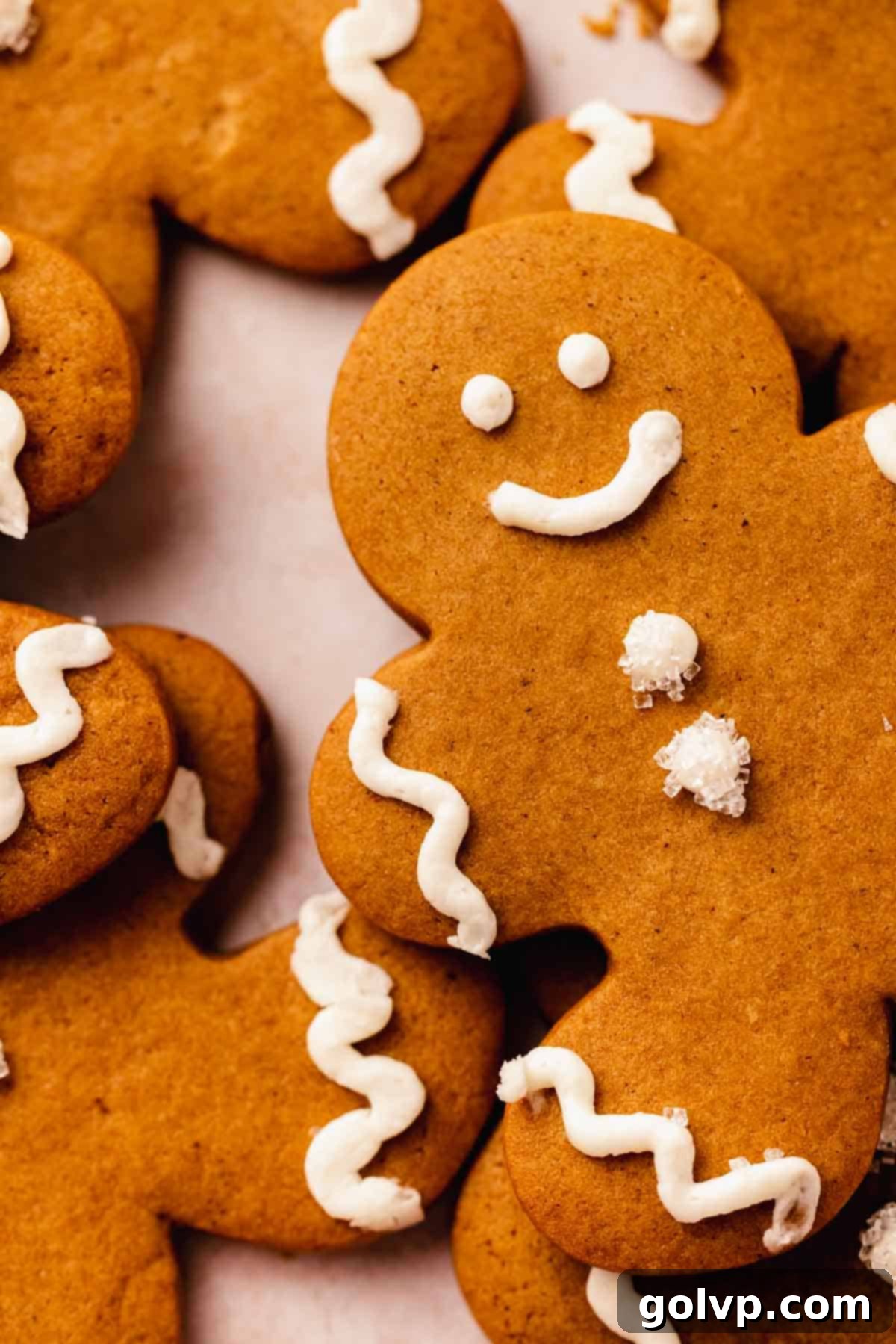
❔ What Are the Best Options to Decorate Gingerbread Cookies?
The beauty of gingerbread cookies lies not only in their taste but also in the endless possibilities for decoration! While I personally love using a classic American buttercream for its ease and delicious creamy texture, several excellent options exist depending on your desired finish and function.
- American Buttercream (as used here): This is my go-to for its straightforward preparation and fantastic flavor. It pipes beautifully, allowing for a wide range of designs, from simple lines and dots to more elaborate patterns. A key advantage of this specific buttercream recipe is that it crusts over slightly once exposed to air, meaning your decorations will become less prone to smudging after a short setting time. It’s perfect for cookies that will be enjoyed at home or shared shortly after decorating.
- Royal Icing: For decorations that require a hard, durable finish, royal icing is the superior choice. Once completely dry, royal icing becomes very firm, making it ideal for stacking cookies, intricate flood-fill designs, or if you plan on shipping your festive treats. It provides a crisp, professional look but does require a bit more technique and time to dry compared to buttercream.
- Simple Glaze: For a quick and easy decoration, a basic powdered sugar glaze (powdered sugar mixed with a touch of milk or lemon juice) can be drizzled or dipped onto the cookies. This offers a sweet, shiny finish with minimal effort.
- Sparkly Sugars & Sprinkles: Don’t forget the fun! Edible glitter, sanding sugars, and various sprinkles can add a wonderful festive touch to any frosting, creating eye-catching textures and shine.
❔ How Do I Prevent Gingerbread Cookies from Spreading and Losing Their Shape?
One of the most common challenges with cut-out cookies is preventing them from spreading in the oven, which can ruin their festive shapes. Fortunately, this recipe is specifically formulated to be no-spread, but following these key tips will ensure your gingerbread cookies maintain their perfect form and lovely soft texture every time:
- Measure Flour with a Scale for Accuracy: This is arguably the most critical tip for preventing spread. Using a kitchen scale to measure flour (450g for this recipe) provides the most precise measurement. Volume measuring (with cups) can vary wildly, leading to too much or too little flour. Too little flour results in a sticky dough that spreads excessively, while too much can make cookies dry and crumbly. Invest in a scale for consistent results!
- Thoroughly Chill the Cookie Dough: After mixing, the gingerbread cookie dough will be sticky, which is exactly how it should be for a soft cookie. Rolling it out between sheets of parchment paper and then freezing it for 30-60 minutes (or even overnight) is absolutely essential. This deep chill firms up the butter in the dough, preventing it from melting too quickly in the oven and causing the cookies to spread. Resist the temptation to add extra flour when rolling, as this can make your cookies tough.
- Always Bake Chilled Cookies: Even after cutting, if your cookie dough shapes have warmed up at all from handling, pop the entire baking sheet of cut cookies back into the freezer for 5-10 minutes just before baking. This ensures they are very cold when they hit the hot oven, giving them the best chance to hold their shape and develop that perfect soft chew without spreading.
- Do Not Overbake: For soft, tender gingerbread cookies, it’s crucial to pull them from the oven when they are slightly underdone. The cookies will continue to bake from residual heat on the hot baking sheet even after they’ve been removed. Look for tops that are no longer shiny and appear slightly puffed up. The edges might be barely golden. Overbaking leads to hard, dry cookies that lose their desirable soft texture.
🎄 Make-Ahead and Storage Tips for Seamless Holiday Baking
These handy make-ahead and storage tips will streamline your holiday baking efforts, allowing you to enjoy fresh gingerbread cookies with minimal fuss.
- Make-Ahead Dough: The gingerbread cookie dough is wonderfully freezer-friendly! You can prepare the dough, roll it out between parchment paper sheets, and freeze it for up to several weeks. When you’re ready to bake, simply pull the frozen dough from the freezer, cut out your desired shapes, and bake as directed. This flexibility makes holiday prep a breeze! For another great slice-and-bake option, try these peppermint shortbread cookies.
- Storing Baked, Undecorated Cookies: Once your cookies are baked and completely cooled, they can be frozen undecorated. Place them flat in an airtight freezer bag or container. To be extra cautious and prevent any sticking, layer wax paper or parchment paper between each layer of cookies. They will keep beautifully in the freezer for up to 2 months. Thaw them at room temperature before decorating.
- Storing Baked, Decorated Cookies: I generally advise against freezing decorated cookies, as the frosting or royal icing can sometimes suffer in texture or appearance during the thawing process, potentially becoming watery or losing its crispness.
- Short-Term Storage: Baked and decorated gingerbread cookies can be stored in an airtight container or bag at room temperature for up to 5 days. For best results, especially with buttercream-decorated cookies, place wax paper or parchment paper between layers to keep the decorations pristine.
💚 How to Make Iconic Gingy Cookies from Shrek
Bring everyone’s favorite sassy gingerbread man to life with these fun decorating instructions! You’ll need a standard gingerbread man cookie cutter with relatively straight arms and legs to best replicate Gingy’s distinct look.
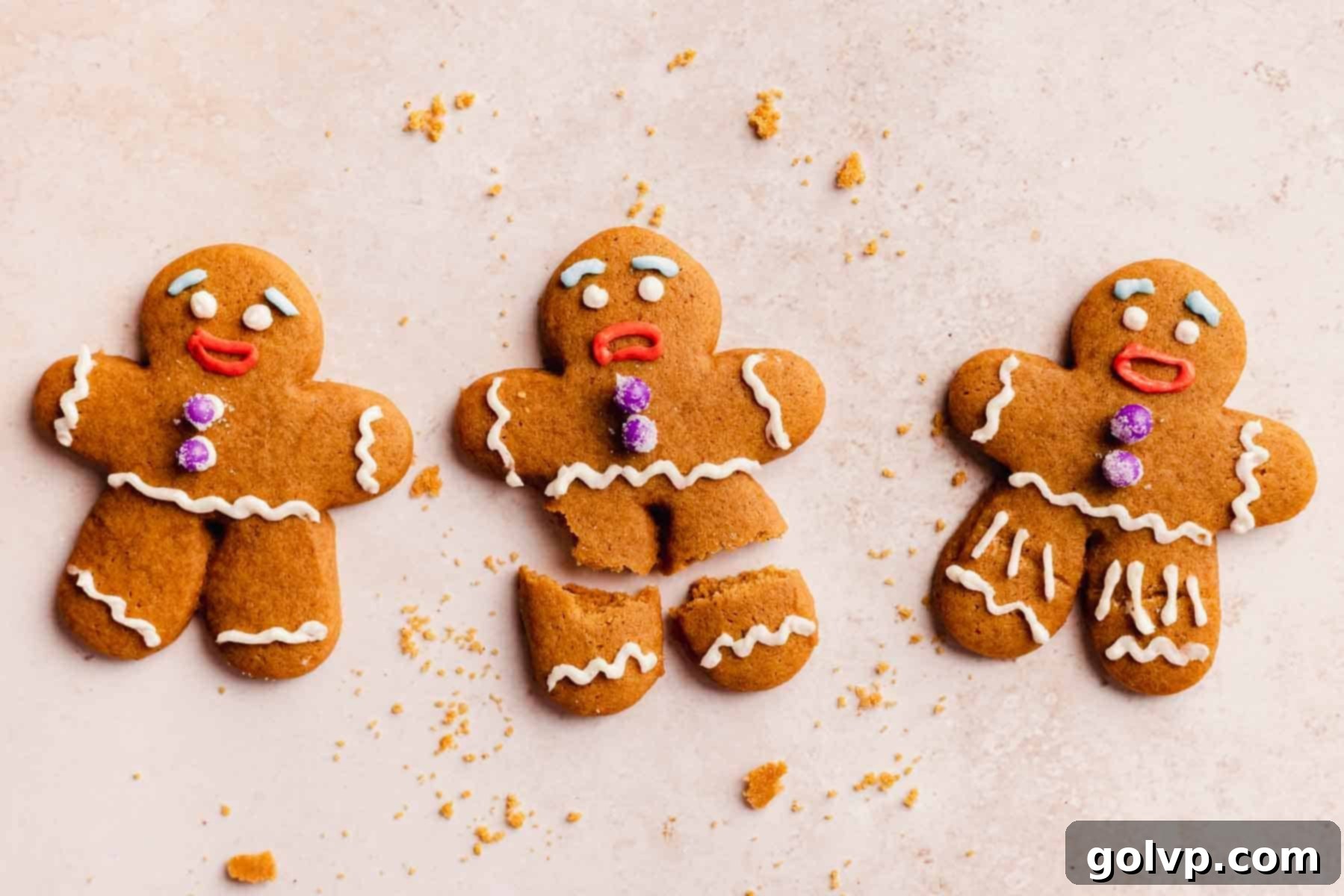
For Gingy’s signature details, you’ll need three colors of frosting or royal icing: a light baby blue, a vibrant red, and classic white. Prepare these colors in separate piping bags with small round tips.
- Using White Frosting: Pipe two round eyes, then add squiggly lines to define his arms and legs, and a waist squiggle. For a touch of movie accuracy, use white frosting to pipe “stitches” on the legs, reminiscent of the memorable scene where Lord Farquaad tragically broke Gingy’s legs during his interrogation! (Watch the classic Gingy interrogation scene here for inspiration!).
- Using Blue Frosting: Pipe raised eyebrows above his white eyes, giving him that classic expressive Gingy look.
- Using Red Frosting: Carefully pipe various open mouth expressions – a wide O-mouth, a smirk, or a frown – to capture Gingy’s personality.
To create his iconic “gumdrop buttons” (Oh, not the gumdrop buttons!), use white frosting or royal icing as an adhesive to attach two purple gumdrop-like candies. If real gumdrop buttons aren’t easily found, a creative alternative is to use purple round sprinkles: slightly moisten them with a drop of water, then roll them in granulated sugar for a sparkly, gumdrop-like effect. Place them firmly on his chest with a dot of frosting. Voila, your very own Gingy!
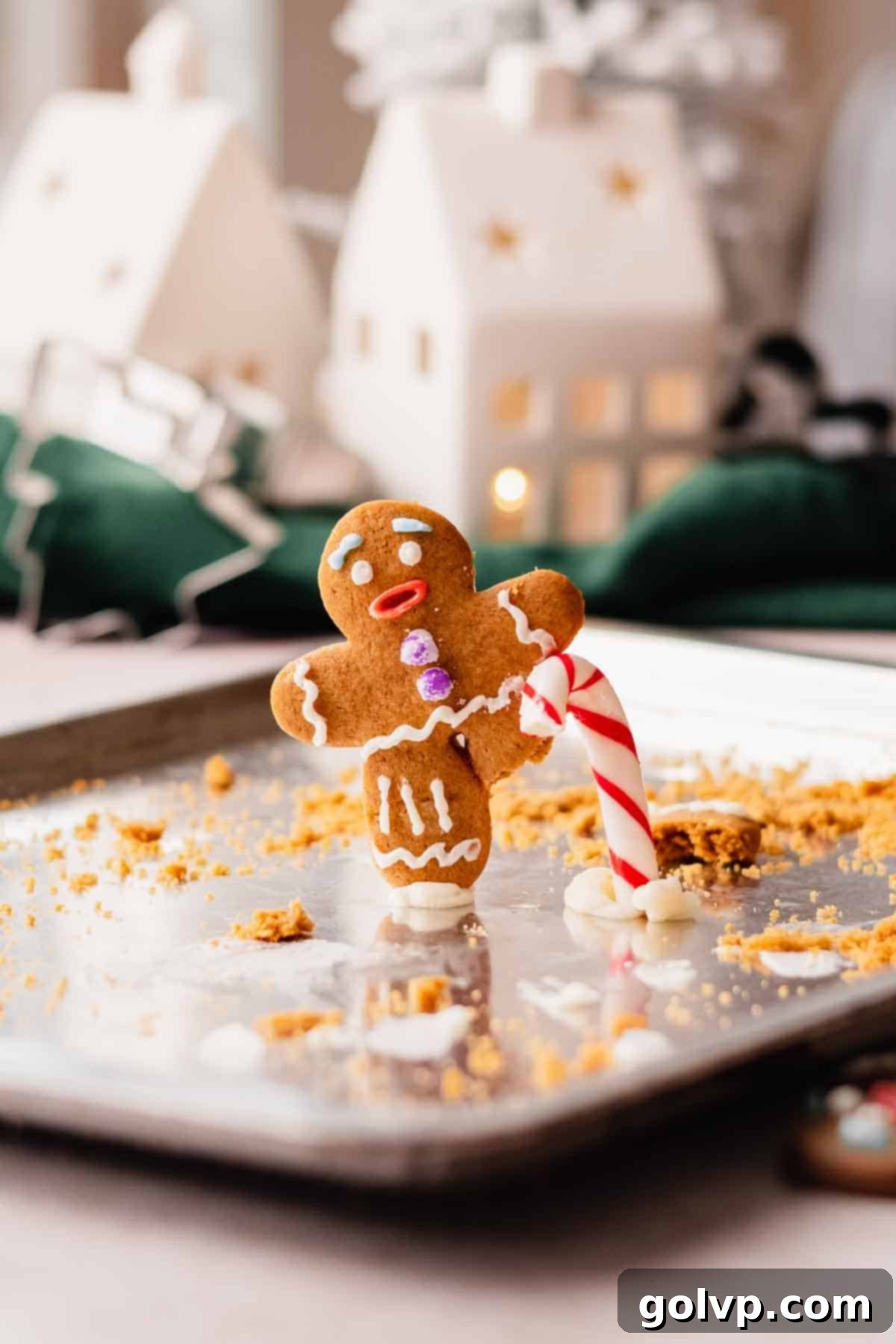
📖 Frequently Asked Questions About Gingerbread Cookies
Absolutely! You can freeze both the unbaked dough and baked, undecorated gingerbread cookies. For unbaked dough, roll it out between parchment paper sheets and freeze flat. For baked cookies, ensure they are completely cooled, then layer them flat in an airtight bag or container with wax or parchment paper between layers to prevent sticking. They can be frozen for up to 2 months. Thaw at room temperature before decorating or serving. Freezing decorated cookies is generally not recommended as frosting can be affected.
Yes, this versatile gingerbread dough can certainly be used for building a gingerbread house! To achieve a sturdier cookie that will hold up well for construction, I recommend adjusting the baking process. Reduce the oven temperature by about 15°F (e.g., to 340°F/170°C) and increase the baking time slightly. This will allow the cookies to dry out more and become firmer, providing a robust structure for your gingerbread house. Just make sure to let them cool completely and harden before assembling.
For decorating your gingerbread cookies, you have a couple of fantastic options. Our preferred choice for ease and delicious flavor is American buttercream, which pipes beautifully and crusts over slightly. If you’re looking for a hard, durable finish that’s excellent for stacking or shipping, royal icing is an ideal alternative. Both allow for creative designs, so choose based on your preference and functional needs!
To achieve crisp edges while maintaining a soft center, the key is thorough chilling of the dough before cutting and baking. Ensure your butter is firm when the cookies go into the oven. Also, avoid over-softening the dough with too much flour during rolling. Bake just until the edges are set and lightly golden, and the center is slightly puffed but still soft. Quick cooling on a wire rack immediately after baking also helps set the edges.
For these gingerbread cookies, unsulphured molasses (either light or dark) is recommended. Unsulphured molasses has a cleaner, sweeter flavor, as opposed to sulphured molasses which can have a slightly bitter taste due to the sulphur dioxide used in its processing. Definitely avoid blackstrap molasses, which is too intense and bitter for baking sweet cookies. Medium or dark unsulphured molasses will give you that classic, rich gingerbread flavor and color.
More Delightful Gingerbread and Cookie Recipes to Explore
If you’ve fallen in love with these gingerbread cookies, you’ll be thrilled to discover more delicious baking inspiration from our kitchen. Expand your repertoire with these other fantastic cookie and gingerbread creations perfect for any occasion, especially the holidays!
- Easy Gingerbread Cinnamon Rolls [No Knead]
- Zesty Lemon Shortbread Cookies
- Irresistible Marshmallow Stuffed Chocolate Cookies
- Classic Buttercream Frosted Sugar Cookies
Did you bring these delightful gingerbread cookies to life in your kitchen? We’d love to hear about your experience! Please take a moment to rate this recipe and share your thoughts in the comments below. Don’t forget to share your beautiful creations on Instagram and tag @flouringkitchen. For more inspiring recipes and baking ideas, make sure to follow us on Pinterest and save your favorites!
📖 Recipe Card: Soft Gingerbread Cookies

Soft Gingerbread Cookies
Mary
Pin Recipe
Shop Ingredients
Equipment
-
electric mixer
-
Cookie sheet
-
parchment paper
Ingredients
Gingerbread Cookies
- 1 cup unsalted butter softened
- 1 cup brown sugar packed
- ½ teaspoon sea salt
-
1 large egg room temperature
- 1 tablespoon pure vanilla extract
- ½ cup molasses unsulphured, and not blackstrap
- 1 tablespoon ginger ground
- 2 teaspoons cinnamon ground
- ¼ teaspoon nutmeg ground
